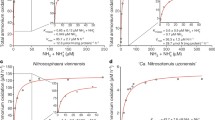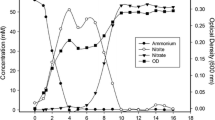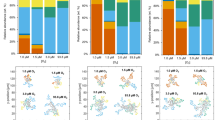Abstract
As a part of a natural biological N-cycle, nitrification is one of the steps included in the conception of artificial ecosystems designed for extraterrestrial life support systems (LSS) such as Micro-Ecological Life Support System Alternative (MELiSSA) project, which is the LSS project of the European Space Agency. Nitrification in aerobic environments is carried out by two groups of bacteria in a two-step process. The ammonia-oxidizing bacteria (Nitrosomonas europaea) realize the oxidation of ammonia to nitrite, and the nitrite-oxidizing bacteria (Nitrobacter winogradskyi), the oxidation of nitrite to nitrate. In both cases, the bacteria achieve these oxidations to obtain an energy and reductant source for their growth and maintenance. Furthermore, both groups also use CO2 predominantly as their carbon source. They are typically found together in ecosystems, and consequently, nitrite accumulation is rare. Due to the necessity of modeling accurately conversion yields and transformation rates to achieve a complete modeling of MELiSSA, the present study focuses on the experimental determination of nitrogen to biomass conversion yields. Kinetic and mass balance studies for axenic cultures of Nitrosomonas europaea and Nitrobacter winogradskyi in autotrophic conditions are performed. The follow-up of these cultures is done using flow cytometry for assessing biomass concentrations and ionic chromatography for ammonium, nitrite, and nitrate concentrations. A linear correlation is observed between cell count and optical density (OD) measurement (within a 10 % accuracy) validating OD measurements for an on-line estimation of biomass quantity even at very low biomass concentrations. The conversion between cell count and biomass concentration has been determined: 7.1 × 1012 cells g dry matter (DM)−1 for Nitrobacter and 6.3 × 1012 cells g DM−1 for Nitrosomonas. Nitrogen substrates and products are assessed redundantly showing excellent agreement for mass balance purposes and conversion yields determination. Although the dominant phenomena are the oxidation of NH +4 into nitrite (0.95 mol mol N−1 for Nitrosomonas europaea within an accuracy of 3 %) and nitrite into nitrate (0.975 mol mol N−1 for Nitrobacter winogradskyi within an accuracy of 2 %), the Nitrosomonas europaea conversion yield is estimated to be 0.42 g DM mol N−1, and Nitrobacter winogradskyi conversion yield is estimated to be 0.27 g DM mol N−1. The growth rates of both strains appear to be dominated by the oxygen transfer into the experimental setups.






Similar content being viewed by others
References
Godia, F., Albiol, J., Montesinos, J. L., Pérez, J., Creus, N., Cabello, F., Mengual, X., Montras, A., & Lasseur, Ch. (2002). Journal of Biotechnology, 99, 319–330.
Hendrickx, L., De Wever, H., Hermans, V., Mastroleo, F., Morin, N., Wilmotte, A., Janssen, P., & Mergeay, M. (2006). Research in Microbiology, 157(1), 77–86.
Pérez, J., Poughon, L., Dussap, C. G., Montesinos, J. L., & Godia, F. (2005). Process Biochemistry, 40, 2359–2369.
Wittebolle, L., Verstraete, W., & Boon, N. (2009). Water Research, 43, 4149–4158.
Delatolla, R., Tufenkji, N., Comeau, Y., Lamarre, D., Gadbois, A., & Berk, D. (2009). Water Research, 43, 1775–1787.
Dytczak, M. A., Londry, K. L., & Oleszkiewicz, J. A. (2008). Water Research, 42, 2320–2328.
Haseborg, E., Zamora, T. M., Fröhlich, J., & Frimmel, F. H. (2010). Bioresource Technology, 101, 1701–1706.
Vadivelu, V. M., Keller, J., & Yuan, Z. (2007). Water Research, 41, 826–834.
Bock, E. (1976). Archives of Microbiology, 108, 305–312.
Sarioglu, M., Insel, G., Artan, N., & Orhon, D. (2011). Journal of Chemical Technology and Biotechnology, 86, 798–811.
Chen, R. D., & LaPara, T. M. (2008). Process Biochemistry, 43, 33–41.
Prosser, J. I., & Embley, T. M. (2002). Antonie Van Leeuwenhoek, 81, 165–179.
Laanbroek, H. J., Bär-Gilissen, M. J., & Hoogveld, H. L. (2002). Applied and Environmental Microbiology, 68, 1454–1457.
Chapman, B. D., Schleicher, M., Beuger, A., Gostomski, P., & Thiele, J. H. (2006). Journal of Microbiological Methods, 65, 96–106.
Güven, D., & Schmidt, I. (2009). Process Biochemistry, 44, 516–520.
Anthonisen, D. J., Loehr, R. C., Prakasam, T. B. S., & Srinath, E. G. (1976). Journal of the Water Pollution Control Federation, 48, 835–852.
Groeneweg, J., Sellner, B., & Tappe, W. (1994). Water Research, 28, 2561–2566.
Arp, D. J., & Stein, L. Y. (2003). Critical Reviews in Biochemistry and Molecular Biology, 38, 471–495.
Princic, A., Mahne, I. I., Megusar, F., Paul, E. A., & Tiedje, J. M. (1998). Applied and Environmental Microbiology, 64, 3584–3590.
Grady, C. P. L., & Lim, H. C. (1980). Biological wastewater treatment, theory and applications (pp. 291–299). New York: Marcel Dekker.
Junier, P., Molina, V., Dorador, C., Hadas, O., Kim, O. S., Junier, T., Witzel, K. P., & Imhoff, J. F. (2010). Applied Microbiology and Biotechnology, 85(3), 425–440.
Haug, R. T., & Mc Carty, P. L. (1972). Journal of the Water Pollution Control Federation, 44, 2086.
Montras, A., Pycke, B., Boon, N., Godia, F., Mergeay, M., Hendrickx, L., & Perez, J. (2008). Water Research, 42, 1700–1714.
Stein, L., & Arp, D. J. (1998). Applied and Environmental Microbiology, 64, 4098–4102.
Bock, E., Koops, H. P., & Harms, H. (1989). In H. G. Schlegel & B. Bowien (Eds.), Autotrophic bacteria (pp. 81–96). Berlin: Springer-Verlag.
Patton, C. J., & Crouch, S. R. (1977). Analytical Chemistry, 49(3), 464–469.
Loveless, J. E., & Painter, H. A. (1968). Journal of General Microbiology, 52, 1–14.
Skinner, F. A., & Walker, N. (1961). Archiv für Mikrobiologie, 38, 339–349.
Drozd, J. W. (1980). In C. J. Knowles (Ed.), Diversity of bacterial respiratory systems (Vol. 2, pp. 87–111). Boca Raton: CRC.
Belser, L. W., & Schmidt, E. L. (1980). FEMS Microbiology Letters, 7, 213–216.
Helder, W., & De Vries, R. T. P. (1983). Netherlands Journal of Sea Research, 17, 1–18.
Keen, G. A., & Prosser, J. I. (1987). Archives of Microbiology, 147, 73–79.
Glover, H. E. (1985). Archives of Microbiology, 142, 45–50.
Hunik, J. H., Bos, C. G., den Hoogen, M. P., De Gooijer, C. D., & Tramper, J. (1994). Biotechnology and Bioengineering, 43, 1153–1163.
Brion, N., & Billen, G. (1998). Revue des Sciences de l'eau, 11, 283–302.
Kantartartzi, S. G., Vaiopoulos, E., Kapagiannidis, A., & Aivasidis, A. (2006). Global NEST Journal, 8, 43–51.
Fang, F., Bing-Jie, N., Xiao-Yan, L., Guo-Ping, S., & Han-Qing, Y. (2009). Applied Microbiology and Biotechnology, 83, 1159–1169.
Park, H. D., & Noguera, D. R. (2007). Journal of Applied Microbiology, 102, 1401–1417.
Gould, G. W., & Lees, H. (1960). Canadian Journal of Microbiology, 6, 299–307.
Gay, G., & Corman, A. (1984). Microbial Ecology, 10, 99–105.
Cox, D. J., Bazin, M. J., & Gull, K. (1980). Soil Biology and Biochemistry, 12, 241–246.
Acknowledgments
The authors thank the European Space Agency for the financial support of this work
Author information
Authors and Affiliations
Corresponding author
Rights and permissions
About this article
Cite this article
Farges, B., Poughon, L., Roriz, D. et al. Axenic Cultures of Nitrosomonas europaea and Nitrobacter winogradskyi in Autotrophic Conditions: a New Protocol for Kinetic Studies. Appl Biochem Biotechnol 167, 1076–1091 (2012). https://doi.org/10.1007/s12010-012-9651-6
Received:
Accepted:
Published:
Issue Date:
DOI: https://doi.org/10.1007/s12010-012-9651-6




